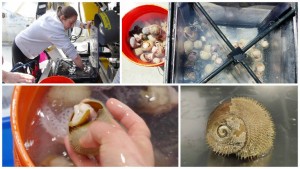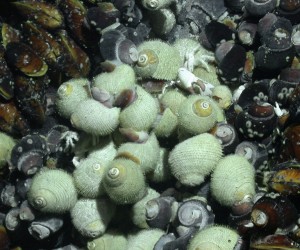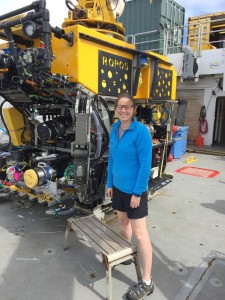19 April 2016
Living Together in the Deep Sea
Posted by larryohanlon
This is the latest in a series of dispatches from scientists and education officers aboard the Schmidt Ocean Institute’s R/V Falkor. This April scientists aboard the research vessel are exploring the life around hydrothermal vent systems 2,400 meters beneath the surface of the South Pacific. Read more posts here, and track the Falkor’s progress here.
By Roxanne Beinart
It is difficult to overstate the importance of microbes to animal and plant life. For example, we rely on microbes in our gut to help us process our food, and many plants rely on associations with fungi to help them extract nutrients from the soil. In the deep sea around hydrothermal vents, mutually beneficial associations with microscopic ‘bugs’ make it possible for animals to survive and thrive in this otherwise food limited habitat. In most parts of the deep sea, animals rely on the sparse rain of food that comes from the sunlit waters above. But around hydrothermal vents, many animals have evolved specific relationships with bacteria that use the chemicals in venting fluid to make sugar, providing them with the nutrition the animals need to survive (as mentioned in the previous blog). These bacteria are often actually found inside the animals’ cells. In other words, the animals are essentially farming their own food inside their bodies.

Once the remotely operated vehicle ROPOS is back on board the ship, the laboratory work begins. The Alvinichoncha snails collected are quickly removed from the sealed biological box and rushed to the lab for immediate processing. Credit: Cherisse Du Preez
Almost seven years ago, we came to the Lau Basin to investigate the diversity and physiology of animal-bacterial symbioses, and found surprising and tantalizing results. In this geologically and geochemically variable region, we found evidence that the populations of the dominant snail Alvinichoncha at these vents were actually comprised of three different closely related species, and these species exhibited associations with different types of microbes, depending on where they were found in the region. The shift in association at sites with different chemistries suggested that as symbiotic pairs (often referred to as holobionts), these pairs of organisms were partitioning their ecological niches. Through analysis of expression of genes related to metabolism, we then showed that these different holobiont pairs were likely making their livings by using different chemicals. All together, this work provided some evidence for the impact of symbiotic microbiota on the distribution of animals at hydrothermal vents, but left many interesting questions unanswered.

The vent dominant snail Alvinichoncha. Discovered to actually be three different closely related species. These species exhibited associations with different types of microbes depending on where they were found in the region. Credit: Charles Fisher and Woods Hole Oceanographic Institute
Returning to the Lau Basin, our mission is to utilize this spectacular natural laboratory to build on our previous findings. Through a series of collections and physiological experiments, we will expand our knowledge of every aspect of this system from the evolutionary connections among these organisms to the broader ecological impacts of these fascinatingly distinct holobiont pairs. Extending our knowledge in this area represents an important step in developing our understanding of the ecology of hydrothermal vent ecosystems, as well as a invaluable opportunity to enrich our rapidly increasing understanding of the ecological impacts of host-associated microbes.
After a brief delay in port we dove into this mission and have been working round the clock acquiring samples and information that will allow us to answer our specific research questions, as well as our broader project goals. The remotely operated vehicle ROPOS has been our hands at the bottom of the sea, allowing us to already collect 60 individual holobionts on two dives from two different vent fields. This initial set of vents is clustered near the southern end of the Lau Basin, where we find all three Alviniconcha species. We are aiming to use further surveys and physiological experiments to discover how symbiont metabolism may play a role in the distribution of these species. Our hope is that through our hours of hard work and missed sleep, we will uncover at least some of the answers to our questions and be able to share these answers with the world.
Dr. Roxanne Beinart is an NSF Ocean Sciences Postdoctoral Fellow at Woods Hole Oceanographic Institution in Woods Hole, Massachusetts. This post originally appeared on the Schmidt Ocean Institute blog.











 GeoSpace is a blog on Earth and space science, managed by AGU’s Public Information staff. The blog features posts by AGU writers and guest contributors on all sorts of relevant science topics, but with a focus on new research and geo and space sciences-related stories that are currently in the news.
GeoSpace is a blog on Earth and space science, managed by AGU’s Public Information staff. The blog features posts by AGU writers and guest contributors on all sorts of relevant science topics, but with a focus on new research and geo and space sciences-related stories that are currently in the news.
Dear Dr.Roxanne
I am exited to learn the content of Deep sea. Is it possible to get the information of decomposition of the microbes inside ocean and the methne gas plume location, please inform me I can work with you in Climate Change programme.
Regards
Saumitra Mukherjee Email: [email protected]
Professor Saumitra Mukherjee PhD (B.H.U.), PGDEE Commonwealth Fellow(UK),Earth Sciences Fellow(India)
Professor of Geology Remote sensing and Space Sciences
School of Environmental Sciences
Jawaharlal Nehru University
New Delhi-110067
India
Website:http://www.jnu.ac.in/Faculty/smukherjee/cv.pdf
Phone:9313908512